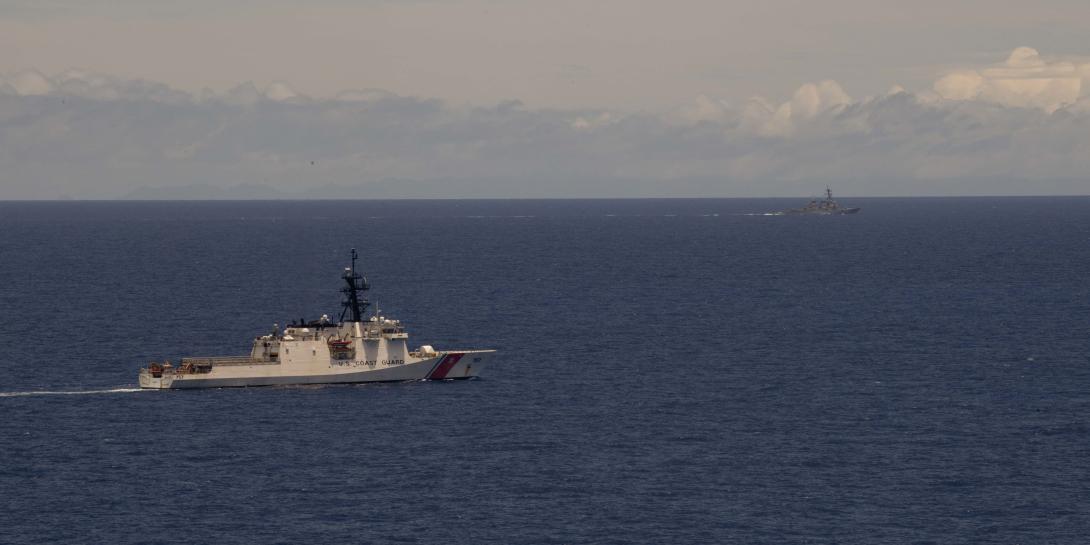Flat Budgets Don’t Deter Sea Services Advances
Despite fiscal restraints and force reductions, the sea services are positioned to improve their capabilities in the coming years. This assessment comes from no less than the commanders of the U.S. Navy, the U.S. Marines and the U.S. Coast Guard, who also described the role that technology will play in building their services’ future
The three leaders spoke at a keynote panel on the second day of West 2021, the conference cosponsored by AFCEA International and USNI running June 29-30. In a panel hosted by former Deputy Secretary of Defense Robert O. Work, the three leaders offered their perspectives on topics ranging from force modernization to the makeup of the personnel staffing their services.
Gen. David H. Berger, USMC, commandant, U.S. Marine Corps, stated, “Our plan and assumption two years ago was that our budgets would be flat.” Yet, even if that proves to be false in the years ahead, the Corps planned to modernize from within by generating its own resources. With flat budgets, the Corps is forced to focus on efficiencies, which he described as “a healthy part of it.”
We want to modernize the Marine Corps from within.—Gen. David H. Berger, USMC, commandant, @CMC_MarineCorps #WEST2021
— Bob Ackerman (@rkackerman) June 30, 2021
The challenge overall is that, if the Corps did not have a pacing threat—the great power competition with China—then it would simply focus on “trying to make the next best version of ourselves, whatever that might be,” Gen. Berger allowed. Now, the Corps must stay in front of the pacing threat.
The Coast Guard is looking to come out of a severe budget slump, related its commandant, Adm. Karl L. Schultz, USCG. From 2013 to 2018, it lost about 10 percent of its purchasing power. The proposed FY 2022 budget has the Guard building on “a healthy glide slope” from where it was in the past two budget cycles, although it still is playing catch-up. “For us, if we can get to 3 to 5 percent steady growth … we can deliver the Coast Guard the nation needs,” he said. He is “cautiously optimistic” that his service will receive the funding it requires.
We may have turned the corner on a positive [budget] glide slope here.—Adm. Karl L. Schultz, USCG, commandant, @ComdtUSCG #WEST2021
— Bob Ackerman (@rkackerman) June 30, 2021
The chief of naval operations, Adm. Michael M. Gilday, USN, said that prioritization will be important if budgets stay flat or decline. For the Navy, some efforts weigh heavily in importance. The National Defense Strategy, the National Security Strategy and the China Task Force all are contributing to potential changes in the Navy. High on the list is joint capabilities, with input from several sources.
Unmanned systems will increase in number and importance. “The hybrid fleet, the growth in unmanned, is part of the journey of [the Navy plan],” Adm. Gilday said. “We’re not going to completely go to unmanned rapidly. But how do we integrate those unmanned platforms—under the sea, on the sea and above the sea—in a complementary fashion with our manned platforms?” In a recent exercise, the Navy teamed unmanned systems in each of the three domains with destroyers, littoral combat ships and a cruiser in live-fire events. “What we’re beginning to learn is how we’re going to actually get to a point where we can make decisions on which platforms we’re going to scale, which ones we can double down on and which ones we can sundown fairly rapidly,” he said.
We’re not going to completely unmanned rapidly. But how do we integrate those unmanned platforms … in a complementary fashion with our manned?—Adm. Michael M. Gilday, USN, @USNavyCNO #WEST2021
— Bob Ackerman (@rkackerman) June 30, 2021
Other technologies will play key roles in the services’ modernization. Adm. Gilday cited data analytics, hypersonics and laser technologies as important capabilities. Data analytics has improved jet fighter readiness, he reported. In hypersonics, “We are on or ahead of milestones on every single test,” he stated, with the goal of fielding that technology on Zumwalt-class destroyers in 2025. Laser technologies offer great promise for fleet survivability.
And, gaming technologies are being applied to both ready relevant learning and live virtual constructive training. They have been critical, he said, citing the gaming community in Orlando, Florida, as offering great advances. And the common thread in warfighting and business applications is artificial intelligence (AI), Adm. Gilday offered.
Gaming technologies have been really critical.—Adm. Michael M. Gilday, USN, @USNavyCNO #WEST2021
— Bob Ackerman (@rkackerman) June 30, 2021
Gen. Berger concurred with Adm. Gilday’s assessments, citing AI and edge computing together as offering the Corps’ greatest potential advantage. Being able to collect, sense, make decisions and be lethal all at the same time and at a greater speed is a Marine Corps goal. AI in personnel elements such as training and management offers opportunities that the Corps wants to tap. “The more you peel it back, there’s three more ways you can use it,” he said.





Comments